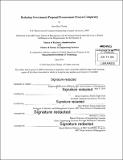| dc.contributor.advisor | Bruce Cameron and Roy Welsch. | en_US |
| dc.contributor.author | Chiang, Jerry Kao | en_US |
| dc.contributor.other | Leaders for Global Operations Program. | en_US |
| dc.date.accessioned | 2014-10-08T15:28:18Z | |
| dc.date.available | 2014-10-08T15:28:18Z | |
| dc.date.copyright | 2014 | en_US |
| dc.date.issued | 2014 | en_US |
| dc.identifier.uri | http://hdl.handle.net/1721.1/90774 | |
| dc.description | Thesis: M.B.A., Massachusetts Institute of Technology, Sloan School of Management, 2014. In conjunction with the Leaders for Global Operations Program at MIT. | en_US |
| dc.description | Thesis: S.M., Massachusetts Institute of Technology, Engineering Systems Division, 2014. In conjunction with the Leaders for Global Operations Program at MIT. | en_US |
| dc.description | Cataloged from PDF version of thesis. | en_US |
| dc.description | Includes bibliographical references (page 73). | en_US |
| dc.description.abstract | US Aerospace Defense Vehicle Manufacturer (UADVM) sells Assembled Complex Equipment to the US Government through multi-year contracts. According to the Truth in Negotiations Act (TINA), such government defense contracts require cost and pricing data as well as supporting documentation, known as material substantiation, to justify pricing and supplier selection. In order to comply with these government regulations, UADVM needed to estimate material costs provided by its supply chain, in a process known as multi-year procurement process. At UADVM, this process involved substantial time, effort, and rework. Through interviews and surveys, total administrative effort to manage the Multi-Year X (MYX) Procurement Process is estimated to be about 41 full-time equivalents (FTEs) per year for three years, translating to an estimated fully loaded cost of $17.3 million. In order to significantly improve the current process, a key area of opportunity is to reduce the complexity of the entire process through 1) reducing the number of inputs, including the number of parts and bids sent out as well as suppliers and price points solicited, and 2) improving the design of the bid strategy, the determination of which parts are bid out to which suppliers, how to group these suppliers and parts into bids, and who should manage these bids in the most efficient and effective manner. Through the analysis of UADVM's MYX data, input reduction can potentially reduce the number of price points solicited by 99.2% and the number of interactions, also known as the number of unique combinations between parts, bids, and suppliers, by approximately 94%. These efforts can be complemented by an improved bid strategy through the use of a data-driven mixed integer linear programming optimization model, which, in tests on a sub-portion of the data, reduces the number of packages by 43%. These methods and analyses for complexity reduction can be generalized beyond current applications at UADVM, aerospace companies, and government proposals; they may be applied to any procurement process where multiple parts, suppliers, and bids are involved. | en_US |
| dc.description.statementofresponsibility | by Jerry Kao Chiang. | en_US |
| dc.format.extent | 85 pages | en_US |
| dc.language.iso | eng | en_US |
| dc.publisher | Massachusetts Institute of Technology | en_US |
| dc.rights | M.I.T. theses are protected by copyright. They may be viewed from this source for any purpose, but reproduction or distribution in any format is prohibited without written permission. See provided URL for inquiries about permission. | en_US |
| dc.rights.uri | http://dspace.mit.edu/handle/1721.1/7582 | en_US |
| dc.subject | Sloan School of Management. | en_US |
| dc.subject | Engineering Systems Division. | en_US |
| dc.subject | Leaders for Global Operations Program. | en_US |
| dc.title | Reducing government proposal procurement process complexity | en_US |
| dc.type | Thesis | en_US |
| dc.description.degree | M.B.A. | en_US |
| dc.description.degree | S.M. | en_US |
| dc.contributor.department | Leaders for Global Operations Program at MIT | en_US |
| dc.contributor.department | Massachusetts Institute of Technology. Engineering Systems Division | |
| dc.contributor.department | Sloan School of Management | |
| dc.identifier.oclc | 891565614 | en_US |
